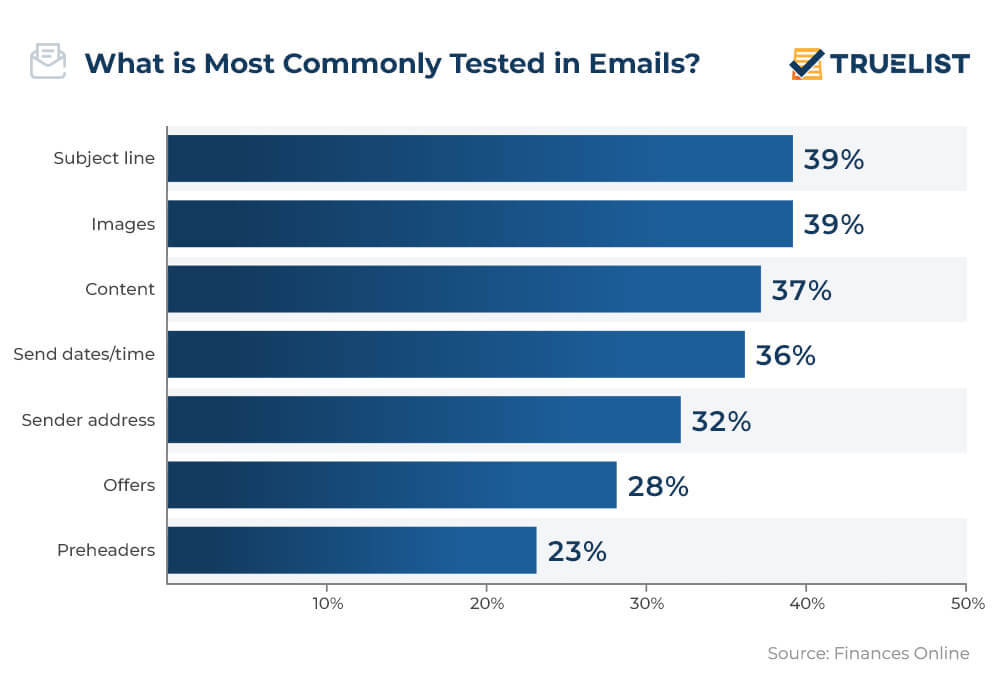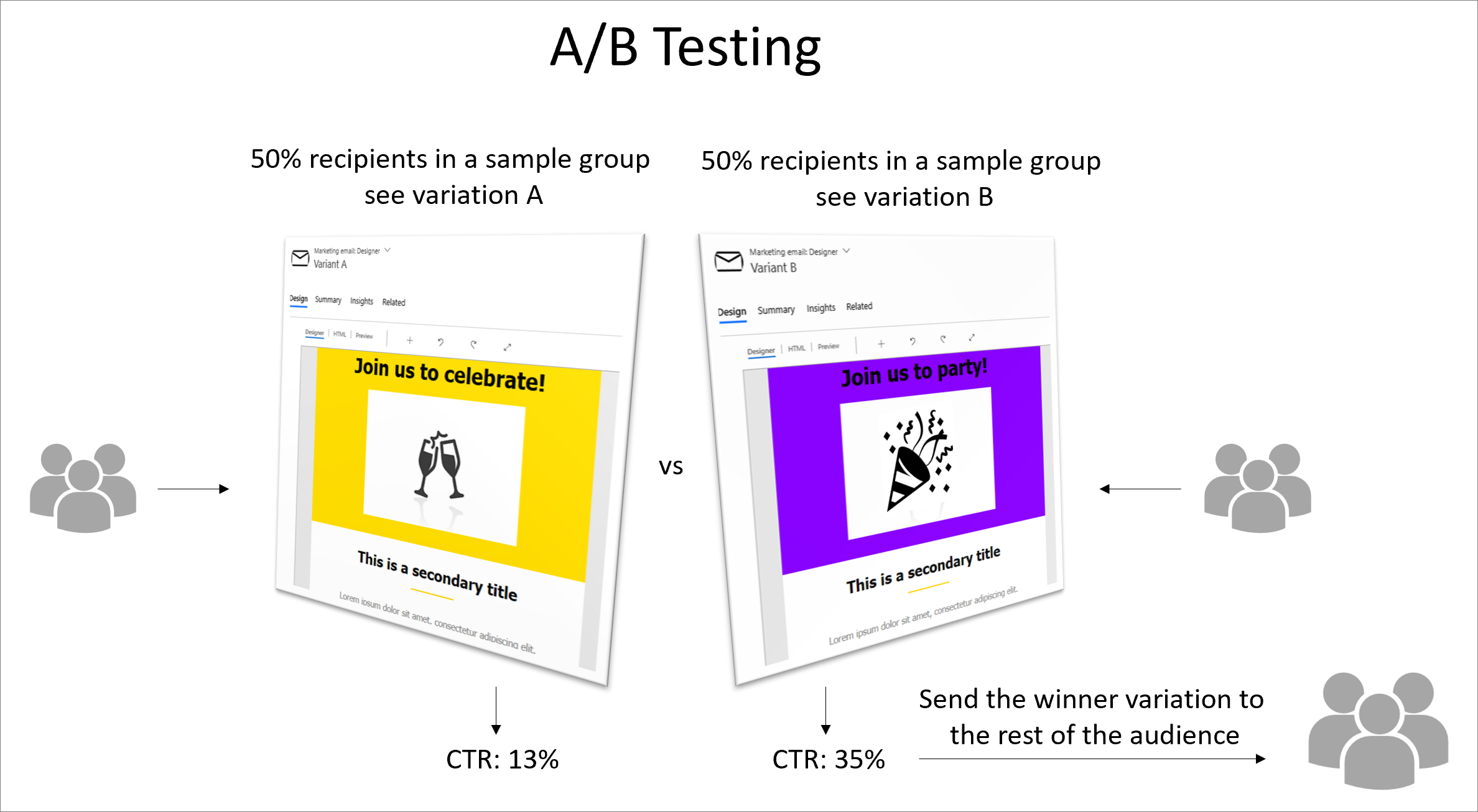How to begin A/B testing email campaigns
Learn how to A/B test your email campaigns and improve open rates, conversion rates, user engagement, sales, profits and ultimately, get a higher return on your marketing investment.

If your company uses email marketing, do you know how to A/B test your email campaigns – and why you should? A/B testing email campaigns is essential to finding the most effective offers and language for your campaigns. Without this testing, your campaigns will likely under perform significantly. A/B testing is essential for email marketing success.
Key takeaways
-
A/B testing sends two variations of a piece to identically-sized sample audiences
-
A/B testing in email campaigns is used to determine which variables perform best
-
Variables can include subject lines, delivery times, pricing, offers, CTAs and general content
-
Marketers use A/B email testing to increase open rates, conversion rates, user engagement and sales
What is A/B testing in email marketing campaigns?
When it comes to email marketing, A/B testing is an essential tool for fine-tuning your messages and offers. Put simply, A/B testing creates two versions of an email document with different messages, language, pricing or offers. The two versions of email content are sent to small sample audiences and the performance of each is tracked. The version with the higher response rate – or, in some instances, the higher dollar volume return – is the version you then roll out to your full target audience.
The goal of A/B testing is to find the combination of language, offer and other elements that performs best. This may be accomplished with a simple one-step A/B test or with a series of increasingly granular tests. Ultimately, this testing should point to the one version of your email that delivers the best results.
The following video examines the science behind A/B testing and why it's important to businesses:
Determining variables
Any part of the email that you can change is called a variable. You can use A/B testing to evaluate a number of variables, including:
-
Subject line
-
From: company name
-
Personalization
-
Send time
-
Opening sentence and first paragraph
-
Landing page content
-
Specific language
-
Product(s) or service(s) offered
-
Call to action
-
Pricing
-
Special offers
-
Layout
-
Visuals
For example, you might test one version of an email with the subject line Check out this special offer and another with the line Here's a special offer just for you. You might also test the response to emails sent early in the morning versus those sent later in the evening. Any variant is open for evaluation, although you probably want to prioritize those that provide the biggest impact.
 Image Source: https://truelist.co/blog/ab-testing-statistics/
Image Source: https://truelist.co/blog/ab-testing-statistics/
Evaluating performance
To determine which is the winning variation, A/B testing lets you choose how performance is measured. You may want to determine the winning version by measuring:
-
Click-through rate
-
Open rate
-
Leads generated
-
Unit sales generated
-
Dollar sales generated
-
Profit generated
For example, you may test one variation with a 15% off offer and another with a 20% off offer. Measuring unit sales might lead to one conclusion and measuring dollar sales to another. However, since the 15% off sales are likely to be more profitable than the 20% off sales, you may want to measure the profit or ROI of each version as the ultimate deciding factor
Why is A/B testing important?
Despite the attention paid to social media and other new online marketing channels, email marketing remains one of the most effective tools for marketers today. According to Litmus' 2020 State of Email report, 78% of marketers say that email is important to the overall success of their company – and 94% say email is one of their top three most effective marketing channels.
When it comes to getting the highest return on your email marketing investment, A/B testing is essential. That's why 59% of companies currently perform A/B testing on their email marketing campaigns. Without A/B testing, you're essentially flying blind; with A/B testing, you can determine scientifically which elements perform the best.
Here are just a few of the proven benefits of A/B testing for email campaigns:
Higher open rates
A/B testing lets you fine-tune the subject line, delivery time, and other elements that affect whether users open your emails. The more enticing the initial impression, the higher the open rates.
Higher conversion rates
When you fine-tune the products, pricing and offers with A/B testing, you entice more customers to respond to your call to action and click through to your website. This results in higher conversion rates, and more qualified leads or paying customers.
Higher sales – and profits
The combination of higher open rates and higher conversion rates results in higher unit and dollar sales. When you use A/B testing to fine-tune your pricing and offer, you generate higher-profit sales with no increase in marketing expense.
Higher user engagement
By optimizing all the variables in a campaign email, A/B testing improves overall user experience. This, in turn, promotes higher user engagement with that specific email and your company or brand in general, and results in higher customer satisfaction and more repeat customers.
Fast results
One of the best things about A/B email testing is that you don't have to wait long for the results. You don't need to conduct months-long market research; you find out almost immediately what variations perform best and can act just as fast. It helps that half of all emails are opened in the first six hours after delivery.
More exact analysis
Analyzing the results of an A/B test is easy – one variation outperforms the other, based on your chosen metrics. There's no more guessing as to what's the best approach; you determine your next steps based on real-world data.
Lower risk
By taking the guesswork out of email marketing, A/B testing lowers the risk associated with your marketing campaign. Your decisions are better informed and, based on the A/B results, you have an indication up front on how well your campaign is going to perform.
How do you A/B test an email campaign?

Image Source: https://docs.microsoft.com/en-us/dynamics365-release-plan/2019wave2/dynamics365-marketing/email-ab-testing >>
A/B testing is as simple as creating two versions of an email, sending them out to similar sample audiences, and measuring the results. Just follow these general steps:
-
Pick the variable you want to test – and test only one variable at a time, for example, an email subject line.
-
Assemble two different versions, one with each variable.
-
Assemble two equally random sets of names to test from your email list.
-
Send one version of the email template to each group, and do it simultaneously – you don't want to introduce timing as an unwanted variable.
-
Let the tests run long enough to generate meaningful results.
-
Measure the results based on predetermined metrics – open rate, dollar sales generated, and so forth.
Based on your results, you may want to conduct further tests on the same variable (testing a half-dozen subject lines, for example) or on different elements. One you've determined the highest-performing variations, you can roll out the finalized email to your larger mailing list.
Turn to Optimizely for fast and effective A/B email testing
When you want to supercharge your email marketing campaigns, turn to Optimizely. Our Digital Experience Platform includes email automation and sophisticated A/B email testing. You can conduct multivariate testing including subject lines, header images, and target segments and immediately incorporate results into your email campaign. You'll drive more revenue and get a greater return on your email marketing investment.
Contact Optimizely today to learn how A/B testing can improve your email marketing campaigns.
